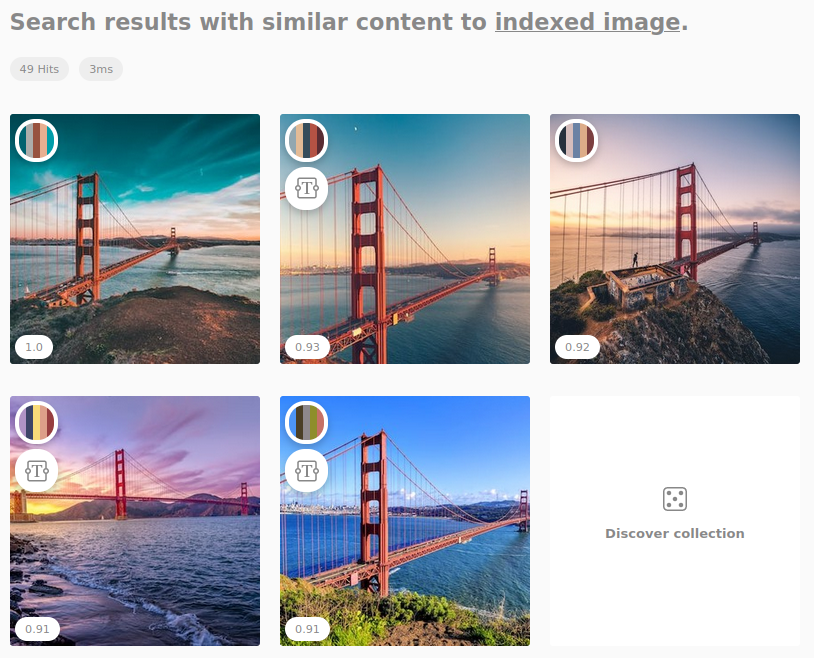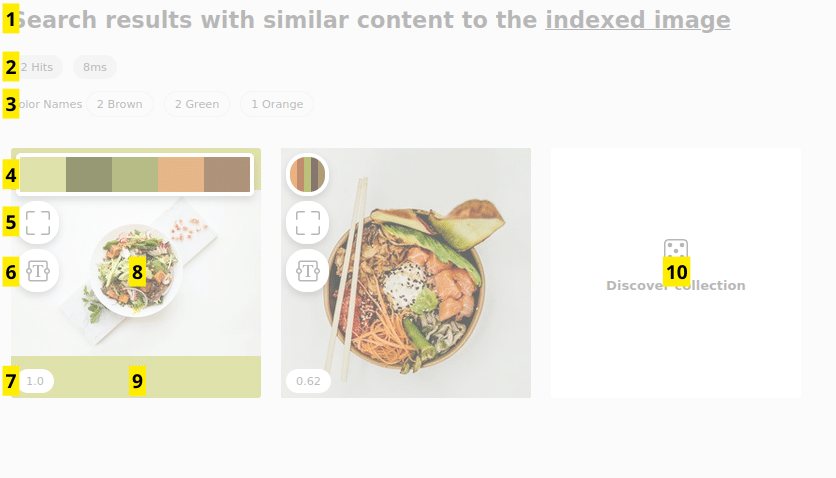Response parameter
Max returned results
The rows parameter pecifies the maximum number of documents from the complete result set to be returned. Default is 10.
rows=[1-1000]
Returned fields
The fl parameter (field list) specifies the list of document fields to be returned in the response.
Default is * (all fields are returned).
fl=[field, fie*, *, score]
The score field is a pseudo-field which has to be included explicitly. Use fl=*,score to return all stored fields and the pseudo-field score.
Only return needed fields
Reading many field values from index impacts performance. Limit the field list to fields that you actually need.
List of pre-configured fields
The following fields are preconfigured (there are more, but these are human readable). They can be used in filter queries fq and as part of the response fl.
idimagelabelscolor_namescolor_isolatedcolor_palette_hexcolor_palette_freqcopyspace
Return color palette
Flow automatically extracts and stores the dominant colors and their frequencies of each image.
The color_palette_hex field contains the dominant colors of an image sorted by frequency in descending order.
Depending on the image, the field contains 1-5 colors as #RRGGBB hex strings.
In addition, the color frequency can be queried via the color_palette_freq field.
This field is also multi-valued and contains the frequency of the dominant colors.
The ith frequency of color_palette_freq belongs to the ith color of color_palette_hex.
The sum of all color_palette_freq values is 1.0.
You can use the color palette to enrich your user interface with the color palette of displayed images and allow color searches using one or more dominant colors of the palette.
Use the built-in HTML response writer as an example of how a color palette can be seamlessly integrated into a user interface to provide additional information and search options.
Response format
The wt parameter (write transformer) specifies how the response is formatted. The default is json.
wt=[json | html | xml | python | php]
The json, php and python response formats can be directly interpreted by the corresponding languages.
wt=html is not supported in Solr Cloud mode.
HTML response

The html response format is intended to ease the inspection of image search results right in your browser since the other response formats are not expressive when it comes to images.
Depending on the returned fields and query parameters the HTML response writer supports displaying facets, scores, detected copyspace, color palette and detected isolated content.
Set fl=*,score to render all supported fields.
Additionally, you can trigger visual search requests by clicking on an image or colors and use it as search input while preserving your current query parameters. This way you can quickly try different search options and see the effects.
To quickly discover the indexed collection, you can click on discover collection to retrieve random results while applying current filter criteria.
You can easily switch back and forth between the various response formats wt, without modifying the search itself.
Below are the UI elements that are generated by the html response format.

- Search title: Description of the search type.
- Response header: Number of hits and the query time in ms.
- Facets: Facets when doing faceted search.
- Color palette: The color palette of the shown image. Click to search for a specific color. Activate with
fl=color_palette_hex. - Background detected: Icon indicates a detected background. Activate with
fl=color_isolated. - Copy space detected: Icon indicates a detected copy space. Activate with
fl=copyspace. - Score: Relevance score of the result. Activate with
fl=score. - Image: The image. Click to search for similar images using content search. Activate with
fl=image. - Ambient coloring: Color the background and the environment when hovering using the most dominant color of the image. Activate with
fl=color_palette_hex. - Discover collection: Click to trigger a random search using the current filter criteria.